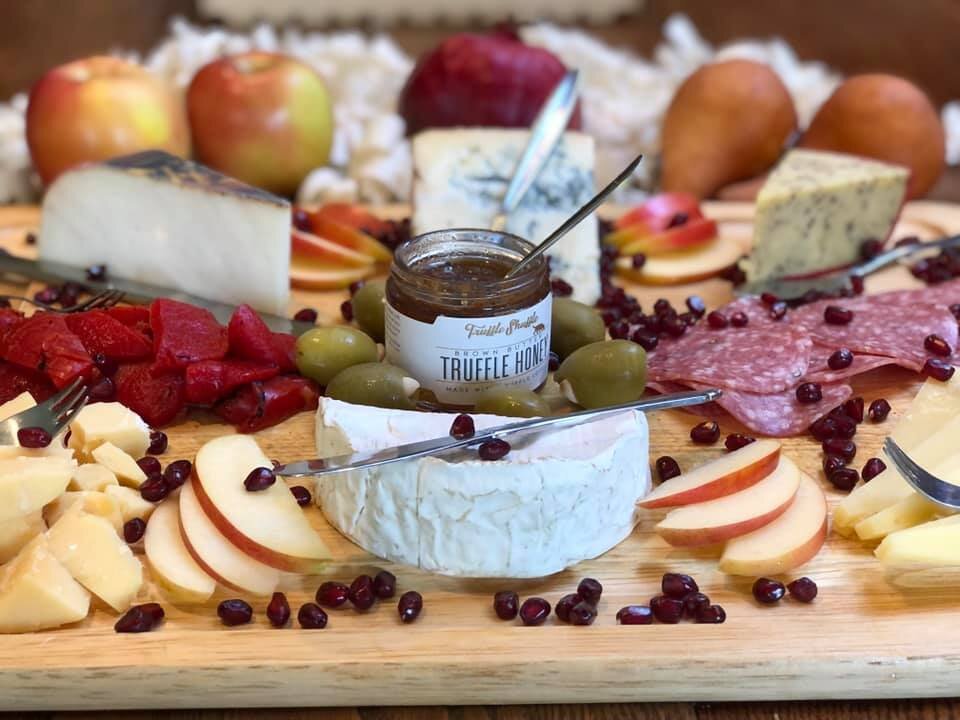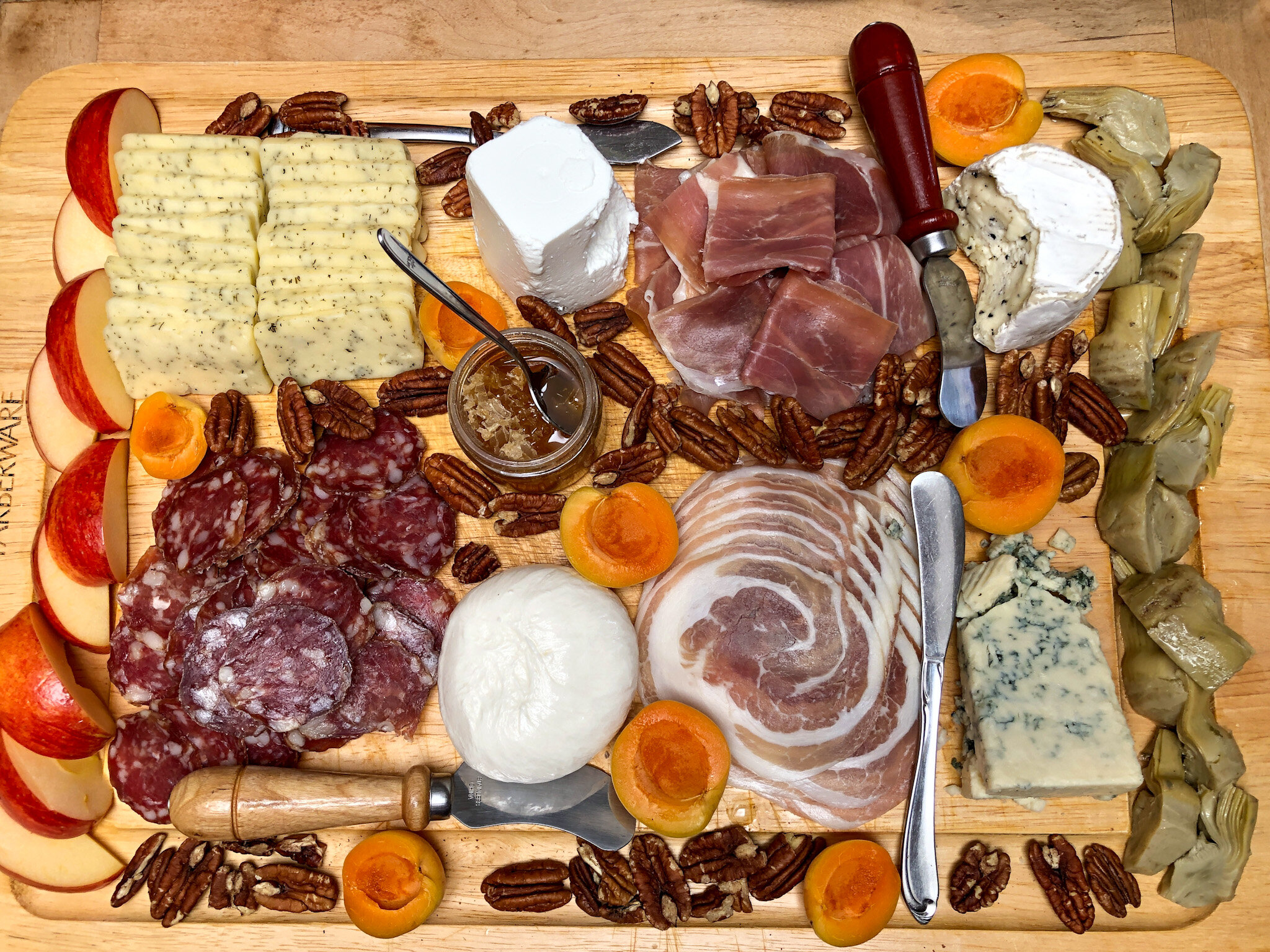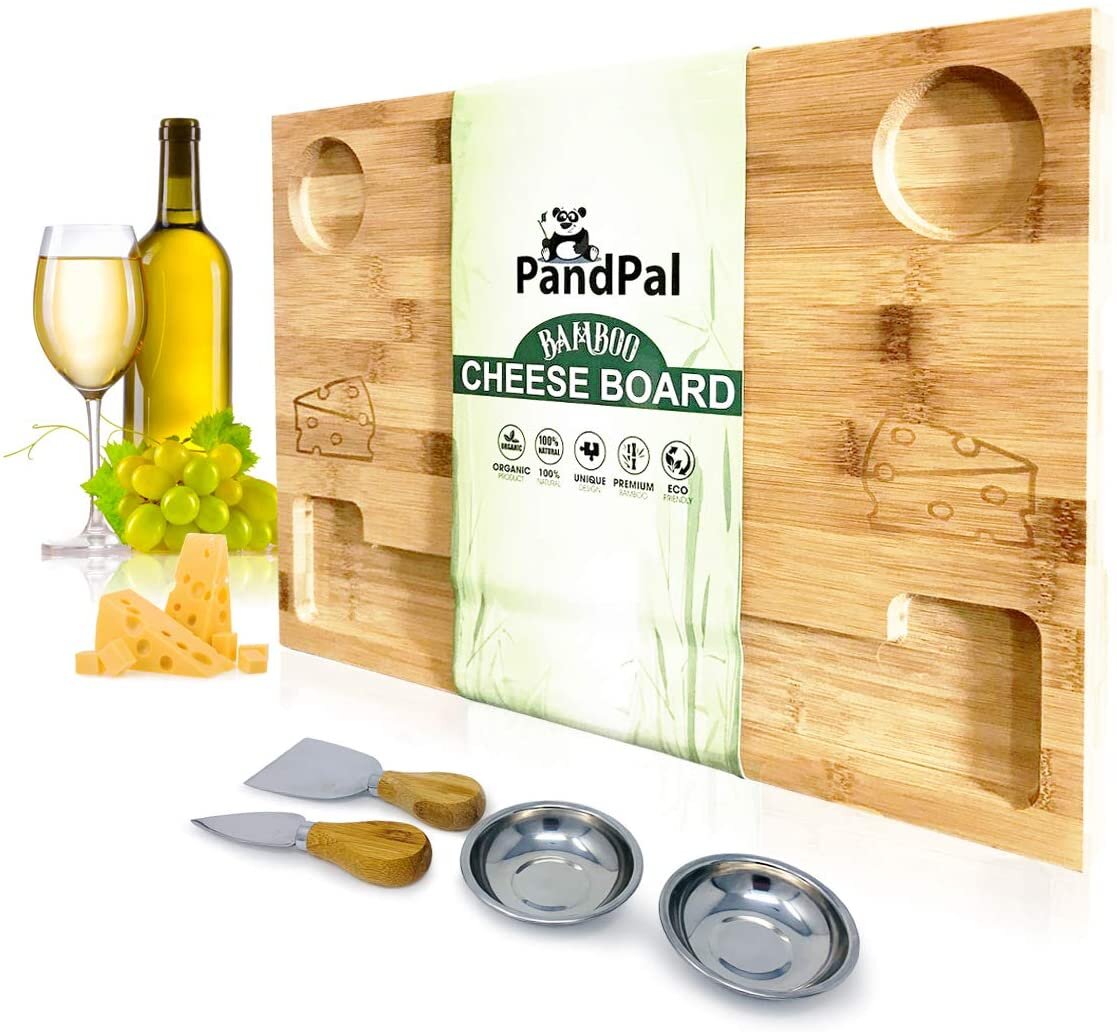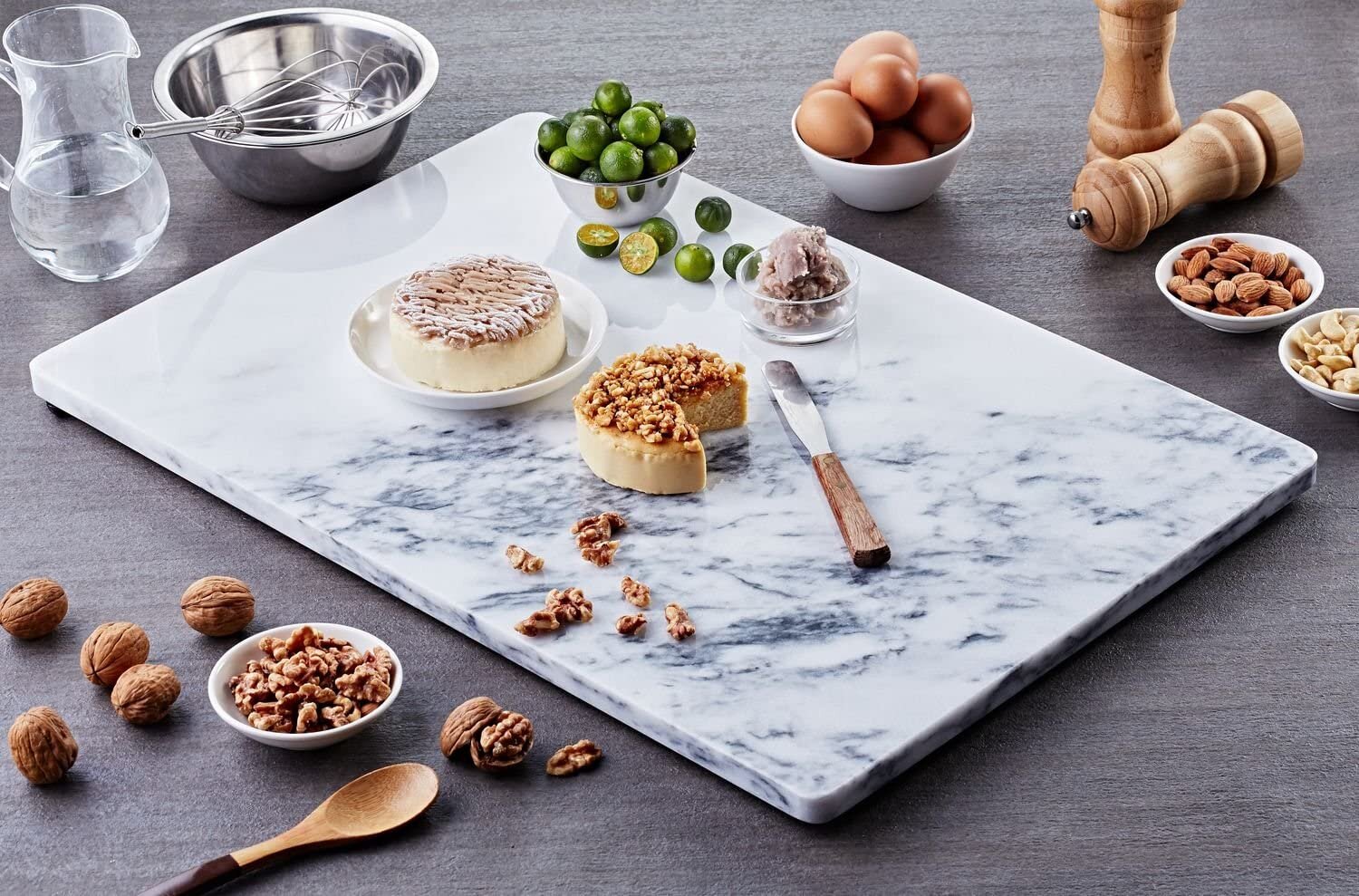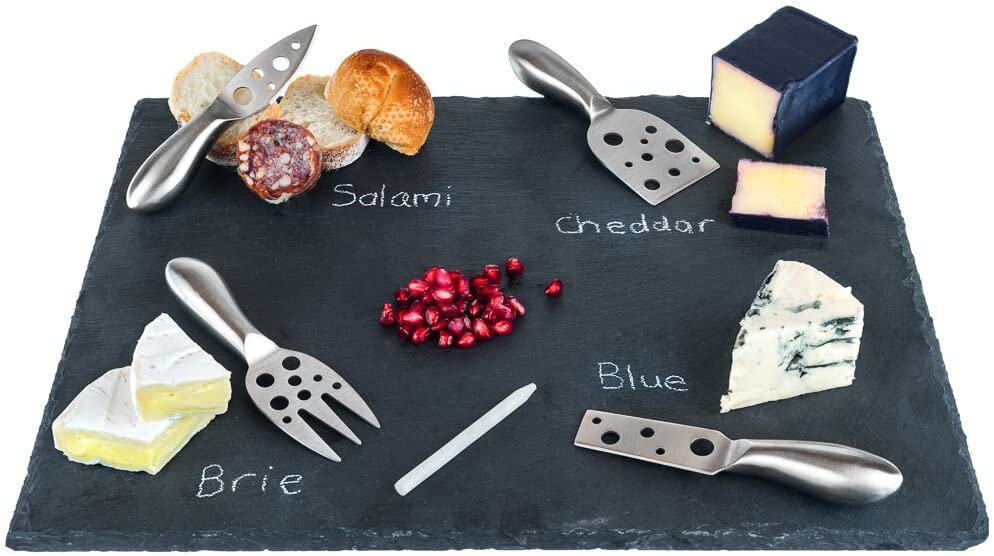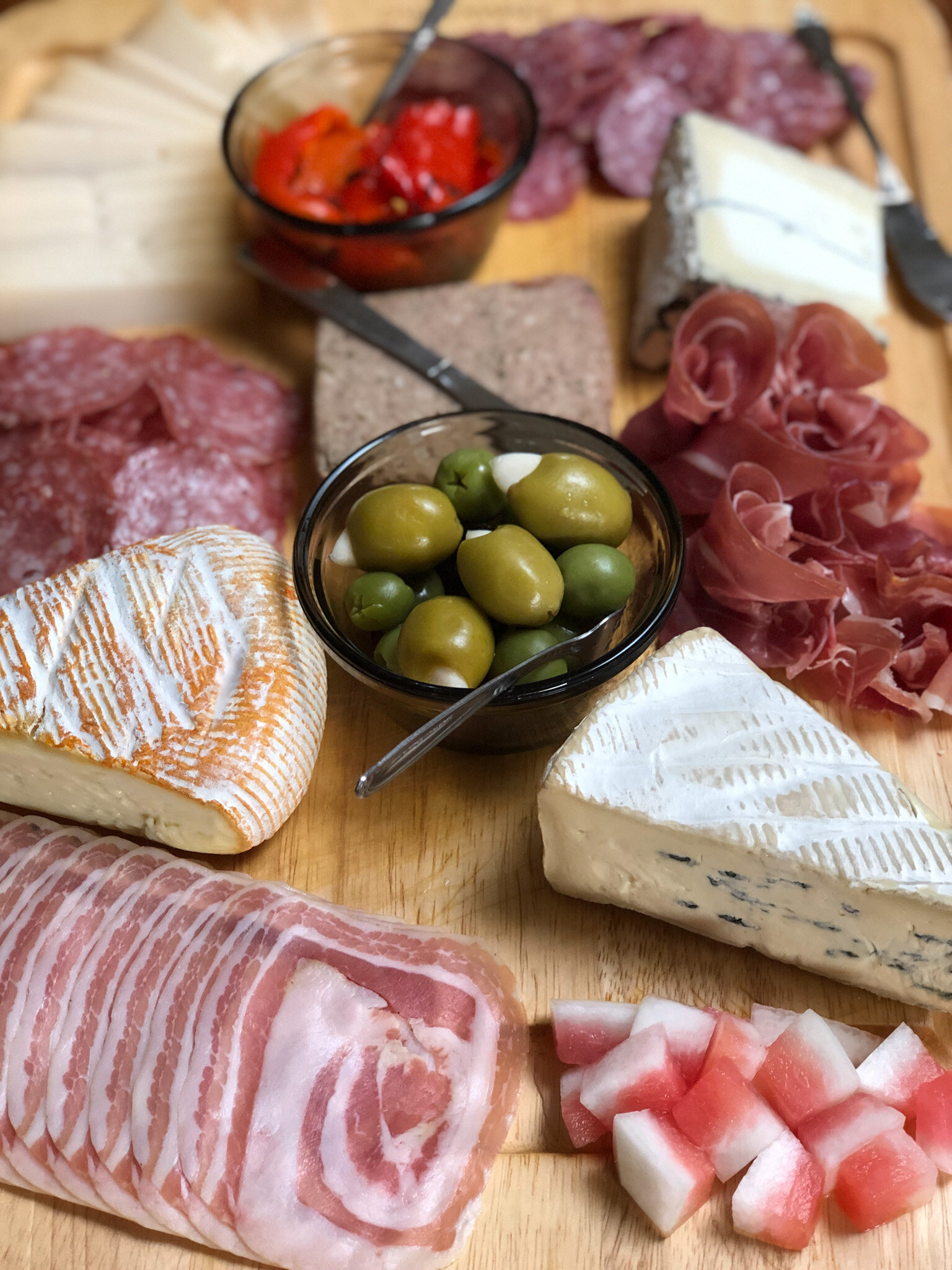Ultimate French Cheese Board: Chef's Secrets Revealed
French Cheese Board
While a well-designed French cheese board can be the perfect appetizer for any dinner party, for me personally, it’s the perfect meal. I am an unabashed cheese lover! On our last trip to Paris, upon arrival, my husband and I dropped our bags at our hotel and immediately ventured out for a heavenly afternoon gorging on French cheese and warm, crusty, French bread.
It’s no secret that French people take cheese very seriously. Not coincidentally, they have the highest cheese consumption in the world, about 57 pounds per person, per year. News Flash: They are not just eating cheese at parties.
In fact, the French will eat cheese any time of day, including after dinner as dessert. So, whether you are creating a platter for a lunch, a dessert, or a party, here’s everything you need to know to create the ultimate French cheese board.
For special holiday boards, see Christmas Charcuterie Board
Cheeses for a French cheese board
A Brief History of French Cheese
From the 1300’s until the 1850’s, women were almost exclusively the cheesemakers of France! Peasant women created regional recipes and sold their cheeses at local markets. For centuries, they kept this custom going by passing the recipes down to their daughters.
However, as science progressed and the number of factories producing industrial cheeses on a large scale increased, women began to lose control of their recipes, and more men started to take over production as cheese making became big business.
The good news is that traditional regional recipes still remain strong, and quality cheese making still ranges from family-run endeavors, to small artisanal operations, to large commercial enterprises. In addition, many cheeses are protected by the appellation d’origine contrôlée (AOC), a French government certification that ensures agricultural products are produced in their location of origin using specific techniques.
Roquefort was the first cheese to obtain this distinction, in 1925. This AOC system is the same regulation program that stipulates that champagne may only be called champagne if it is indeed from Champagne, France. The system is intended to ensure high-quality cheeses and other agricultural products through the use of time-tested methods of production and select ingredients from a specific locality.
Today, every region in France produces an array of cheeses, with the Normandy region being the largest producer nationwide. Different regions of France specialize in different types and styles of cheese, resulting in an almost mindbogglingly diverse selection of French cheeses from which to choose.
Types of French Cheeses
Types of cheese for a French cheese board
If you think a French cheese board would be inconceivable without Brie or Camembert, think again! While I do swoon over a perfectly ripe double crème brie, there are between 1,200 and 1,600 distinct kinds of cheese in France, depending on who you talk to. The French categorize them into eight families of cheese. Some of them are only available in France, although most you can find in Paris cheese shops. So when I’m in the French capital, I always buy some fromage to bring home from the source. After all, cheese makes a great souvenir from Paris!
| Cheese Family | Characteristics | Popular Cheeses |
|---|---|---|
| Soft Cheeses with A Bloomy Rind (Natural Rind) | • Cow’s milk • Soft Cheese • Natural white fluffy rind • Aged one month | Camembert, Brie, Delice de Bourgogne, Brillat Savarin and Neufchâtel |
| Soft Cheeses with A Washed Rind | • Cow’s milk • Soft Cheese • Moist orange rind • Strong odor | Pont-l’Évêque, Maroilles, Mont-d’Or, Muenster, Livarot. Epoisses |
| Pressed Cheeses | • Cow’s or ewe’s milk • Semi-hard or semi-soft • Thick hard rind • Aged for several months | Tomme de Savoie, Cantal, Morbier, St. Nectaire, Port Salut, Ossau-Iraty |
| Cooked Pressed Cheeses | • Cow’s milk • Hard cheese | Comté, Beaufort, Emmental, Mimolette |
| Blue Cheeses | • Cow’s or sheep’s milk • Blue mold “veins” • Aged approximately 2 mo. | Roquefort, Bleu de Bresse, Saint Agur, Bleu des Causses, Fourme d'Ambert, Bleu d’Auvergne |
| Goat Cheeses | • Goat’s milk Soft Aged two to six weeks | Chevrotin, Chavignol, Pélardon, Rocamadour, Chabichou du Poitou, Crottin de Chavignol, Fleur du Maquis, Sainte-Maure, Soignon |
| Fresh Cheeses | • Cow’s, sheep’s, or goat’s milk Creamy texture Not aged High water content | Jonchée d’Aunis, Brousse Provençale Petit Suisse, Brousse |
| Processed Cheeses | • These cheeses are produced by melting cheeses or a mixture of cheeses. | Gruyère cream, processed cheeses with nuts, Boursin |
Of course, when creating your fantastic cheese board, it all starts with the cheese.
Creating the Ultimate French Cheese Board
French Cheese Selection
Whether constructing a traditional French cheese board, French cheese platter, or French cheese plate, do not feel compelled to include all eight cheese families! Well, then, how do you choose which ones to incorporate?
First, decide on a quantity. The French insist on an odd number of cheeses. I recommend 3 or 5 French cheeses depending on the number of people sharing and whether you’ll be serving anything else.
Ideally, select a variety of different flavors, textures, colors, shapes, and degrees of firmness, and don’t include anything you personally don’t like. Here are some of the best French cheeses to make your cheese board a hands-down hit, even if it’s your first time putting one together:
Epoisses: A truly classic French cheese from the Burgundy region. Made from either pasteurized or unpasteurized milk from local cows, this cheese’s super creamy inside borders on runny, and has a powerful combination of sweet, salty, and tangy elements.
The gasses that escape the orange washed rind can have a slightly pungent or “stinky” odor. Don’t let that worry you; it’s a small price to pay for the cheese’s uniquely complex flavor, which is considerably milder than its aroma.
Delice de Bourgogne: Think of this cheese as Brie on steroids. It’s a triple cream bloomy rind cheese with 75% fat and a silky texture that melts in your mouth. It’s definitely a favorite cheese of mine, and if you haven’t yet tried it, do so! I’m betting it will become a favorite of yours too.
Ossau Iraty: Fabled to originate from a Greek god’s follies, this sheep’s milk cheese has a 3,000-year-old history and hails from the Pyrenees region in southern France. The semi-firm pressed cheese has a mild taste of nuts and toasted wheat.
Comté: France’s answer to Gruyère has a similar mild brown-butter flavor and semi-hard texture. It is often used for melting, especially in fondue. With its taste, texture, and versality, it’s no wonder Comté is considered one of the world’s best cheeses.
Mimolette: This fabulous bright orange hard cheese from the area around Lille gets its color naturally from annatto. With its notes of caramel and nuts, Mimolette has a distinctive flavor profile, and its appealing hue offers a great way to add color to your cheese board.
Morbier Cheese
Morbier: Easily identifiable by the layer of flavorless ash running through its center, this semi-soft cheese comes from the Franche-Comté region. It is rich and creamy with hints of fruit, hay, and nuts.
Roquefort: A famous food from France! This quintessential French blue is crafted from sheep’s milk. It crumbles easily and delivers a rich, spicy tang. Fun fact: Roquefort first shows up in history in 79 AD in the writings of Pliny the Elder.
St. Agur: A wonderfully creamy blue cheese from the mountains of Auvergne in central France. The rich buttery taste and texture will please even the blue cheese timid.
Chabichou du Poitou: This mildly sweet goat cheese in the shape of a small cylinder can add a touch of cute to your platter.
Sainte-Maure de Touraine: A log-shaped goat cheese covered in vegetable ash from the Loire region.
Accompaniments
Choose a few complementary items that will not only look pretty but enhance the flavors of your selected cheeses. Sweet condiments like honey or jams, and dried or fresh fruit usually pair well with most cheeses, as do most nuts.
If you want something more like a main course, you can include olives, marinated artichokes, and roasted peppers. Making lots of possible flavor combinations provides taste buds with a delightful workout. Here are a few of my personal favorite accompaniments:
Bread & Crackers: I love bread almost as much as cheese, so I make a special trip to the bakery before putting together the perfect French cheese board. Sliced fresh baguettes or rustic sourdough bread set the stage nicely, but you should use whatever you like most. In addition, put out an assortment of crackers of varied sizes, shapes, and textures, some seeded, some not.
Truffle Honey: I love to pair this with a blue cheese and roasted walnuts. It’s addictively delicious! And this one by Truffle Shuffle is by far the best one I’ve ever had!
A perfect cheese board pairing: truffle honey, blue cheese, and pecans
Maple bacon onion jam: This is especially delicious on a wedge of Ossau Iraty or Comté.
Fig jam: This choice evokes a hint of the Mediterranean and goes particularly well with any blue cheese.
Sliced pears and apples: I like to have these as pairing choices that supplement the traditional bread or cracker options.
Roasted or candied pecans: Most nuts will work well, so if you prefer almonds, or another nut, use those.
Charcuterie: If the cheese board is not for a meal, I tend to use just one type of charcuterie on my platters. I am all about the cheese after all! Prosciutto or salami are my two favorites, and if you really want to use both, go for it! If the French board is for a meal, the more meats the better. In fact, my husband insists that the best French cheese board is one that gets twinned up with a hearty charcuterie platter.
For more information about how to round out your French cheese board, see my Best Charcuterie Board Condiments article.
The Board
Cheese boards are typically made from wood, slate, bamboo, or marble and vary greatly in size. Cutting boards and pastry boards make great cheese boards too! For the perfect cheese board presentation, make sure your board is large enough for everything you want to have on it. Check out these fabulous cheese board options from Amazon:
Cheese Board Presentation Tips
Now that you have everything you need for your perfect French cheese board, it’s time to create a beautifully appetizing presentation. Some things to keep in mind:
Temperature: Cheese is best enjoyed at room temperature, so make your platter about an hour ahead of serving.
Quantity: The cheese board should be full, but not overflowing. Don’t feel compelled to use all of your cheese. Each portion of the cheeses you choose should be approximately the same portion size.
Placement: Map out your design before putting the cheese down on the board; it will save you time and messy clean up. Start with the cheese first and fill in with your accompaniments and bread/crackers. If you are using 5 cheeses and a rectangular board, try putting one cheese in each corner and the star of the show in the center.
Cutting: You don’t want your cheese flinging across the room when someone goes to cut it (I actually saw this happen once in a restaurant). Slice the hard and semi-hard cheeses and serve with a tiny fork. From my catering experience, I also know people are much more likely to take a slice of hard cheese than to cut their own.
Utensils: Have a cheese knife for each cheese that you have not precut. A separate knife for each cheese is an easy way to keep the flavor of each choice distinct.
Bread and crackers: Stack crackers to save space, place them staggered along the sides, or space them between the cheeses. If you cannot fit the bread or crackers on the platter, it is OK to serve them in a separate plate, bowl, or basket.
Fill in the blanks: Try not to leave large gaps in your display. Position small bowls with little spoons for jams and honey. Make piles of, or scatter, dried fruits and nuts. If you feel like you still have too much extra space, you can fill it in with fresh herbs or edible flowers.
Make Your Amazing French Cheese Boards Even Better!
Even though there is no such thing as a perfect French cheese board recipe, I know that the French cheese board ideas that I’ve offered above will definitely help anyone upgrade a basic cheese board to something top notch. And just a little time and experimentation will let your arrangement shine even brighter every time you assemble it.
Nowadays, it’s typically not too challenging to find a good range of French cheeses in the United States, so if you have a good cheese store near you, sample before you buy.
Good cheese shops are happy to have you taste a variety of the cheeses they have on offer, and helpful personnel can answer many of your questions and even offer tips to help you find exactly what you’re looking for.
Try new cheeses often to give yourself the best chance of finding the next one that you really love. If you find a new star, sub it for the weakest link on your last French cheese platter. This way you’re always upgrading your assortment.
Also experiment with new fruits, veggies, jams, crackers, spreads, and breads. This is an easy way to enhance your accompaniment offerings over time.
Now, just a few words about wine. Pairing wines and cheese is both a science and an art. The biggest challenge is that just about every cheese goes best with a different wine. My advice: Don’t drive yourself crazy.
To accompany your fantastic cheese board, pick a mix of red wine, white wine, and sparkling. If you want to go with French wine, great—but it’s in no way mandatory. Urge guests to try different wines over the course of the cheese tasting. Different wines will complement different cheeses; the key is to have a good time finding out which combinations work best.
And I meant what I said about loving cheese. I would also love to hear from you about your French cheese experience. Let me know in the comments below what some of your favorite French cheeses are, what accompaniments you find work well for you, and/or what innovative pairings or display ideas you’ve tried. I’ll be eating cheese and waiting for your feedback.
Once you’ve created your board, also feel free to use any of these fun charcuterie board captions for your social media when posting about your creation! And if you love cheese anywhere near as much as I do, please check out my articles on the most popular cheeses of Italy and Greek cheeses.
Bon appétit!

